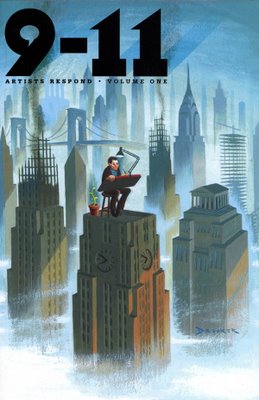 9-11 Artists Respond - Volume One (192 pages, full color)
9-11 Artists Respond - Volume One (192 pages, full color)This collection from DC Comics features an extraordinary lineup of comics' top creators, as well as many lesser known artists. As you would expect with any anthology of this size and variety, the contributions range from the extraordinary to the mundane. I have spotlighted many of my personal favorites below, though there are definitely others that deserve consideration. Overall, in terms of quality and diversity, this is probably the strongest of the four anthologies.
The cover, as well as a stunning 2 page scratchboard contribution by Eric Drooker are among the highlights of this volume. The image of the solitary artist, alone at his drawing table in the center of such destuction is a powerful metaphor and a fitting opening to the contents of this book.
 Rather than wallowing in the horrors, or trying to make profound statements about the meaning of the tragedy, David Chelsea's true story about Philip Petit, the French daredevil who tightrope walked between the two Towers back in 1974, is fascinating and a clever tribute to the legacy of the towers. The two-page strip is drawn and colored in a style imitating McCay's Little Nemo, and is one of the most memorable contributions in the book.
Rather than wallowing in the horrors, or trying to make profound statements about the meaning of the tragedy, David Chelsea's true story about Philip Petit, the French daredevil who tightrope walked between the two Towers back in 1974, is fascinating and a clever tribute to the legacy of the towers. The two-page strip is drawn and colored in a style imitating McCay's Little Nemo, and is one of the most memorable contributions in the book.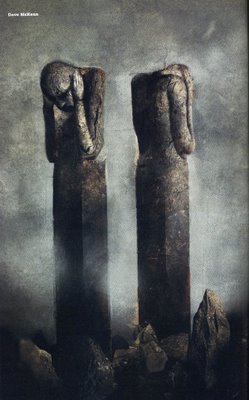 Like his many Vertigo covers over the years, Dave McKean's painting of the Towers as mourning totems is haunting. The image, entitled "Reason" shows two stone figures covering their ears, no longer willing to listen to reason.
Like his many Vertigo covers over the years, Dave McKean's painting of the Towers as mourning totems is haunting. The image, entitled "Reason" shows two stone figures covering their ears, no longer willing to listen to reason.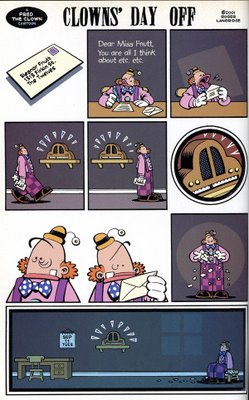 Roger Langridge's Fred the Clown strip shows a tasteful and heartfelt lack of a punchline, executed in the artst's familiar silent, vaudeville cartoon-style.
Roger Langridge's Fred the Clown strip shows a tasteful and heartfelt lack of a punchline, executed in the artst's familiar silent, vaudeville cartoon-style.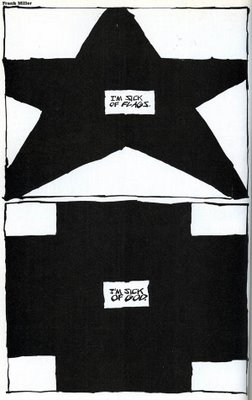
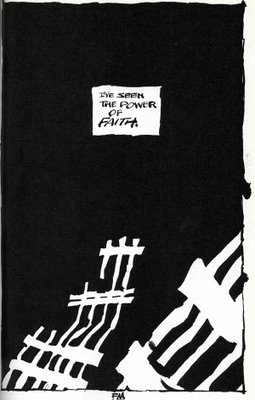 Frank Miller's poem about the power of faith is chilling in its simplicity, a reaction against the fundamentalism that lead to the attacks in the first place. Miler's stark black and white images deliver the harshness of its blunt message perfectly.
Frank Miller's poem about the power of faith is chilling in its simplicity, a reaction against the fundamentalism that lead to the attacks in the first place. Miler's stark black and white images deliver the harshness of its blunt message perfectly. R. Sikoryak has an uncanny ability to perfectly imitate the drawing style of just about any prominent comic strip artist (such as Cathy artist Cathy Guisewite above). In his two-page newspaper broadsheet contribution, Sikoryak parodies several different strips with various fragments of conversations overheard in New York in the days after the attacks. The result is a clever combination of storytelling style with candid, honest reactions from everyday New Yorkers.
R. Sikoryak has an uncanny ability to perfectly imitate the drawing style of just about any prominent comic strip artist (such as Cathy artist Cathy Guisewite above). In his two-page newspaper broadsheet contribution, Sikoryak parodies several different strips with various fragments of conversations overheard in New York in the days after the attacks. The result is a clever combination of storytelling style with candid, honest reactions from everyday New Yorkers. Little known children's book artist, Kellie Strom, contributes one of the most beautifully illustrated pieces in the entire anthology, a two-page dream sequence of a girl floating through the ruins of a building.
Little known children's book artist, Kellie Strom, contributes one of the most beautifully illustrated pieces in the entire anthology, a two-page dream sequence of a girl floating through the ruins of a building. Another artist unknown to most comics fans, Steve Guaraccia, contributes a simple yet powerful variation on Rene Magritte's famous painting. As far as I can tell from Googling him, this is Guaraccia's only work in comics.
Another artist unknown to most comics fans, Steve Guaraccia, contributes a simple yet powerful variation on Rene Magritte's famous painting. As far as I can tell from Googling him, this is Guaraccia's only work in comics. Al Davison's "Ground Zero" illustrates a dream he claims to have had on Sept. 9, 2001, in which several children are wandering around some ruins. Their tears flow into the barren earth to create this beautiful tree above. Not only is it one of the single most striking images in the entire book, it's fascinating that Davison had this premonition so close to the actual tragedy.
Al Davison's "Ground Zero" illustrates a dream he claims to have had on Sept. 9, 2001, in which several children are wandering around some ruins. Their tears flow into the barren earth to create this beautiful tree above. Not only is it one of the single most striking images in the entire book, it's fascinating that Davison had this premonition so close to the actual tragedy.
Though I haven't included them here, there are several other contributions worth checking out. Dean Motter's "Before the Fall" recounts several poignant memories about the lower-Manattan neighborhood where he used to live and take his dog on walks. Jim Mahfood's "Arab Americans" is a personal series of character profiles based on people he knew growing up. Mahfood himself is half Arab, and grew up in a mostly Arab community in St. Louis. Will Eisner contributes a moving essay about the souls of buildings, a theme he has explored throughout much of his life's work. Bob Harris and Greg Ruth's two-pager, "Which One is Real?" explores many of the confusing dichotomies and mixed messages we're fed by the major media outlets, and how difficult it is to make sense out of it all. Finally, the book ends with a six-page story by Lost Girls creators Alan Moore and Melinda Gebbie. The story takes a philiosphical look at how information is conveyed, through language, visual experience, and energy within the universe. It's certainly an interesting and thought-provoking ending.

3 comments:
Nice Blog, some interesting info and thoughts, a bit radical for me at times but thats ok.
Hi.
I linked to your reviews of both volumes in my own review of them. Thanks, and check it out.
http://reviewingwhatever.blogspot.com/2006/09/9-11-artists-respond-vol-1-and-2.html
Hi, i thought the spoof on magritte's work was amusing, and the frank miller's work was exceptional. thanks for sharing this info and insights. I'm a big fan of Dave Mckean's work also!
Post a Comment